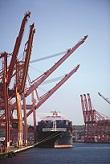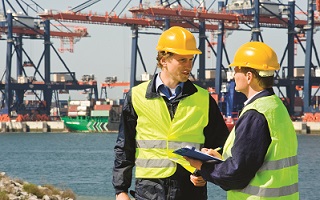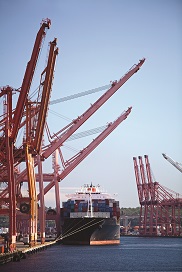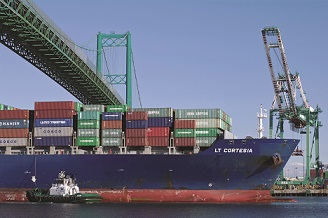

Ports are always working to attract new business by improving their facilities and ensuring that goods flowing through their terminals have access to trade corridors, but they are – in many ways – at the mercy of large trade patterns and global economic trends.
While mainstream media has focused a great deal on the Panama Canal expansion – and certainly the expansion is a newsworthy item and will likely significantly affect global trade – there are many other factors currently driving global trade trends. One critical factor is the location of manufacturing centers within Asia. While China has been a key source of imports to the Western Hemisphere in recent decades, as the Chinese middle class grows and demands higher wages so they can consume the things they produce, manufacturing has started to shift south within the continent to places where labor costs are lower.
“China is now a major export destination for the United States,” said Walter Kemmsies, chief economist at Moffatt & Nichol. “As [Chinese] workers are being paid more, less is being exported [from China]. Factories are moving to Vietnam, Pakistan, Thailand and Indonesia.”
The distance from Shanghai, China, to Hanoi, Vietnam, is approximately 1,900 km (or 1,200 miles) southwest – roughly the same distance and direction as Boston, Massachusetts, to Mobile, Alabama, or from Rio de Janeiro, Brazil, to Montevideo, Uruguay. This distance, coupled with the local geography of many growing furniture, textile and consumer goods production centers, is enough to begin changing some of the math for determining the most efficient and cost-effective route to North American consumers.
“As manufacturing moves south, the trend is toward the Suez [Canal],” said Bob West, principal strategist within WorleyParsons’ Ports & Marine Terminals Division. “By going through the Suez, vessels have a lot of markets along the way in Europe and the Middle East and can put together strings from Europe to North America.”
Specifically, the Suez route is ideal for reaching the dense population centers of the U.S. East Coast and the shift toward Asia-U.S. shipping via the Suez is currently benefitting East Coast ports.
“But the shift from China to south Asia will not mirror the explosion of Chinese imports that happened” a couple of decades ago, Kemmsies warns. The effect on global transportation is more likely to be incremental and the all-water route across the Pacific to the U.S. West Coast will likely remain popular.

“India suffers from bad port infrastructure, but if they improved, they could expand manufacturing there as well,” said West.
Even with subpar infrastructure in many cases, the lower transportation costs associated with southern Asian cities are encouraging some shippers to use the Suez route to reach U.S. population centers.
But Paul Bingham, economic practice leader of CDM Smith, cautions that looking at transportation costs alone may not be a solid predictor for determining long-term trends in trade lanes.
“If ocean carriers had the ability to sustain profits and get rates up, some of that ocean cargo would get priced off low-cost ocean routes,” Bingham said. “Low costs have opened up routes as BCOs [beneficial cargo owners] have realized the cost savings.”
Low costs are also behind the current push for the ever-increasing capacity of container ships. It’s more cost-effective for carriers to fill megaships, such as the Mary Maersk, which recently came online with a capacity of 18,000 TEUs. While these behemoths are designed primarily with the Asia-Europe routes in mind, they have a trickle effect for other vessels in the fleet.
“The Mary Maersk may never come to U.S. ports, but 10,000- or 12,000-TEU ships don’t have any problem with the Suez and won’t have problems with many U.S. East Coast ports,” said West.
However, ports must be prepared to address congestion as they attempt to handle these larger ships.
“Ports have been congested as they have struggled to figure out how to adapt to the larger vessels that are hitting U.S. container ports,” said Kemmsies.
In some cases, congestion is working in favor of ports as the crowded north-south rail network has led to the shipment of some autos from Mexico to the U.S. on water routes.
“Because these vessels are international vessels and not smaller Jones Act vessels, the effect on ports is the same,” said Bingham. “In the long run, the service premium from rail will probably trump port access; however, for certain coastal markets, shippers may establish an all-water service and keep it.”
North-south trade lanes also may realize some of the benefits of the Panama Canal expansion.
“Asia will certainly be the most important trade route in terms of the Panama Canal expansion,” said Bingham, “but it could make a big difference for certain lanes that go from the west coast of South America to the U.S. East Coast – especially in refrigerated cargo and other more delicate perishables.”
Agricultural exports of all kinds are also poised to play a large role in shifting trade lanes, especially those that focus on exporting U.S. goods.
“There is a lot of demand for U.S. exports, especially agricultural products, large capital goods such as power plant components and aircraft and energy products,” said Kemmsies.
Of agricultural products in particular, Bingham said, “The United States has great potential as increasing populations can afford [U.S. products.] The U.S. is still looked to as an incredibly safe source for anything to consume.”
 Exports may benefit from further trade agreements, which are expected to increase in the wake of approval of Trade Promotion Authority for the President this summer. International trade agreements, including the Trans-Pacific Partnership (TPP) and Transatlantic Trade and Investment Partnership (TTIP) could boost American exports and create new economic opportunities and jobs for American workers, manufacturers, farmers, ranchers and entrepreneurs.
Exports may benefit from further trade agreements, which are expected to increase in the wake of approval of Trade Promotion Authority for the President this summer. International trade agreements, including the Trans-Pacific Partnership (TPP) and Transatlantic Trade and Investment Partnership (TTIP) could boost American exports and create new economic opportunities and jobs for American workers, manufacturers, farmers, ranchers and entrepreneurs.
Ports are trying to stay ahead of these trade trends by investing in facilities and improving port productivity and working to ensure that federal partners do their share when it comes to freight connectors.
American Association of Port Authorities’ (AAPA’s) “2015 The State of Freight” report highlighted the need for federal investments in U.S. ports. Congestion is on the rise at land-side seaport connectors, and congestion is hurting port productivity. Investments are needed to improve road, rail, bridge and tunnel connections.
In AAPA’s freight transportation infrastructure report, U.S. port leaders indicated the need for immediate and significant investment in the land-side arteries that carry freight to and from the nation’s seaports. Without adequate investment in the connecting infrastructure with America’s ports, the nation’s economy will suffer, the jobs that ports produce and the international competitiveness they sustain will erode, and American workers, families and employers will experience burdensome and costly hardships.
The changing landscape of U.S. trade makes these infrastructure needs more pronounced than ever. Ports will continue to invest on their own – and urge federal partners to invest as well – so that goods can flow smoothly for the economic benefit of the nation, no matter how larger trade trends fluctuate.
